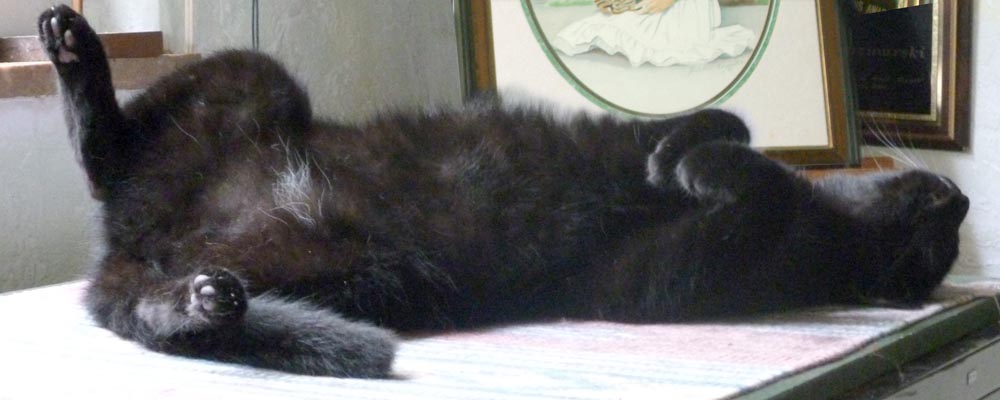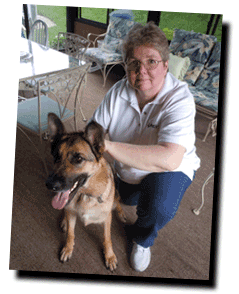The Snout-To-Tail Wellness Assessment

by Karen Sable, Guest Columnist
As part of Pet Wellness Month, one action every pet parent can learn to contribute to their pet’s wellness is to frequently perform their own Snout-To-Tail Wellness Assessment.
This “tool” is a systematic and deliberate method for evaluating and knowing the status of your pet’s everyday health. It allows you to learn what is “normal” for your pet, and therefore to be able to more quickly recognize something that is not normal, making early detection more likely.
It can also be a good bonding experience for you and your pet. The Wellness Assessment ideally should be done at least once a week, with the results of each assessment documented. By examining your pet from Snout-to-Tail on a regular, ongoing basis, and keeping records of each assessment, you are able to detect any irregularities (lumps, bumps, swelling, tenderness, secretions, etc.), and also identify and changes since your last assessment. This can provide vital information for following up with your Vet.
The Snout-To-Tail Wellness Assessment is a skill that is best learned by taking a Pet Tech “PetSaver” or Pet CPR and First Aid class, such as those I teach, but the following steps summarize what is involved in the assessment. You’ll be able to download this as a checklist with a link at the end of this article.
- To make the process an enjoyable one for you and your pet, and also to allow you to focus on the assessment, you should perform it in a quiet place that is free from distractions for you and your pet. Your pet can be sitting or lying down, whatever position is comfortable for you and your pet, and allows you to purposefully touch your pet from snout to tail.
- Start at the snout, and both touch and examine your pet’s nose. It’s not true that the nose should be cold and wet. It should not be so wet that there is a discharge, or so dry that it’s cracked. Then run your fingers over the muzzle and check for any lumps, bumps, sores, or abrasions.
- Check inside your pet’s mouth. Unless you have a pet whose gums are naturally dark in color, such as a Chow, the gums should be bubble gum pink. The teeth should be white, with no chipped, cracked, or missing teeth. And, there should be no bad odor. Bad “puppy breath” is not normal.
- Next check the eyes. They should be clear with no discharge, should track movement. Look for any differences between the two eyes. Are the whites of the eyes white, or are they red or yellow? Are the pupils pinpoint, dilated, or unequal?
- Next move to the head and check the skull, along the sides of the head, and back over the neck. Do you feel or see any bumps, masses, or sores? Does your pet react at all as if any spot is tender?
- The ears are next. They should not have any discharge or odor, and should not be painful to the touch. Compare the ears to each other. Do they look at all different from their normal appearance (eg. If both ears are normally erect, is one now laying down).
- Now check the back/spine. Run your hand along the full length of your pet’s spine down to the base of their tail with a firm, gentle pressure. Do you feel any lumps or bumps? Does your pet give any sign of discomfort?
- Now move your hands to the chest and ribs. You should be able to easily feel the ribs under the fur. “Love Handles” are not a good thing in our pets. With your hand on your pet’s chest, you can check both their breathing rate, and quality. Feel the rise and fall of their chest and count the number of breaths per minute. Normal breathing rate for dogs ranges from 10-30 breaths per minute; for cats it’s from 20-30 per minute. You need to determine what is normal for your pet at rest, as it can fall anywhere within the “normal” range. Their breathing should be smooth, easy, and rhythmic.
- After checking the chest and ribs, check each front leg and paw. Note the range of movement, and any sign that there is pain when the limb is moved. Check the claws, including the dew claws. None should be cracked, split, or painful. Check the pads of the feet and between the toes. Many pets do not particularly like to have their feet touched, so you may have to go slowly on this part, and even bribe your pet with a treat while examining their feet.
- Next move to the hind legs and paws, and repeat the exam you did on their front legs. While examining their rear legs, that’s the best time to check their pulse at the femoral artery. The femoral artery is located on the inside of the thigh of either back leg. The normal pulse rate for an adult dog can vary between 60-140 beats per minute, depending on the size and even the breed. Cats can have a pulse rate between 110-240 beats per minute. Given the wide range, it really is important to establish what the normal resting pulse rate is for your pet.
- After examining the hind legs/paws, use the flats of your hands and palpate the abdominal area. The abdomen should not be sensitive, painful, hard, or rigid. You also should check your pet’s mammary glands and genital areas for any signs of discharge. And, the anal area should not have any accumulation of feces or debris. You should also get in the habit of taking your pet’s temperature using a digital, rectal thermometer. The normal temperature for dogs and cats ranges from 100.4° – 102.5°. Again, it’s important for you to know just what is “normal” for your pet. If you are at all unsure how to properly take your pet’s temperature, ask your vet, or take a Pet First Aid class.
- The final step of the assessment is to do an overall examination of your pet’s tail, skin, and coat. Check the tail for any deformity or sign of pain. Check their coat for quality, color, texture, or any excessive shedding.
Every time you do a Snout-to-Tail Assessment, you should keep a written record of your findings. This allows you, and your vet, to track any patterns or changes over time, and makes it easier to detect anything that is not normal for your pet.
If you do discover any abnormalities or changes from one assessment to the next, it is advisable that you discuss your findings with your vet as soon as possible so that they can determine what, if any, treatment or follow-up care is warranted.
We all want our pets to live as long and healthy a life as possible, as their companionship and unconditional love add so much to our own lives and well being. By taking the steps outlined above, we are doing our part to help make that possible.
Downloadable checklist
Click here to download a PDF of just the list formatted with checkboxes and space for notes. The file will open in a new window, and depending on your browser settings may ask if you want to save or open the file. If not, from the menu at the top you can choose “File>Save Page As” or find the icon in the lower menu.

About Karen Sable
Karen Sable, owner of Pet Emergency Training, LLC, completed the Pet Tech Instructor program in March, 2011 and teaches pet first aid classes in the Pittsburgh area. Karen is a trained responder with several national animal response/rescue teams, including American Humane’s Red Star Animal Emergency Services Team, United Animal Nations’ Emergency Animal Rescue Service, and Noah’s Wish Disaster Response Team. She is also a member of the PA/Allegheny County Animal Response Team, and a volunteer animal rescue transporter.
In addition to having a Veterinary Assistant diploma, Karen’s training certifications include Emergency Animal Sheltering, Large Animal Rescue, Animals in Disaster, Livestock in Disaster, Hazardous Materials, Incident Command and National Incident Management. As a former healthcare Human Resources Director, Karen now devotes her extensive training experience, and love of animals, to teaching pet care professionals and fellow pet parents the skills and knowledge that can save their pets and improve the quality of their pets’ lives. Visit her website at Pet Emergency Training, LLC.
Also read other articles by Karen Sable on The Creative Cat.
Read more about Karen in The Creative Cat Welcomes Guest Columnist Karen Sable.
All images used on this site are copyrighted to Bernadette E. Kazmarski unless otherwise noted and may not be used without my written permission. Please ask if you are interested in using one in a print or internet publication. If you are interested in purchasing a print of this image or a product including this image, check my Etsy shop or Fine Art America profile to see if I have it available already. If you don’t find it there, visit Ordering Custom Artwork for more information on a custom greeting card, print or other item.


Pingback: The Creative Cat - Help Your Pets to Stay Well
Pingback: Winter Pet Safety « The Creative Cat
Pingback: Holiday Pet Safety « The Creative Cat
Pingback: Cookie’s Little Incident, Senior Kitties, and Keeping Your Pets Well « The Creative Cat
Pingback: Senior Pets Make Great Friends! « The Creative Cat
Pingback: Help Your Pets to Stay Well « The Creative Cat
Pingback: National…International…Today is Cat Day! « The Creative Cat